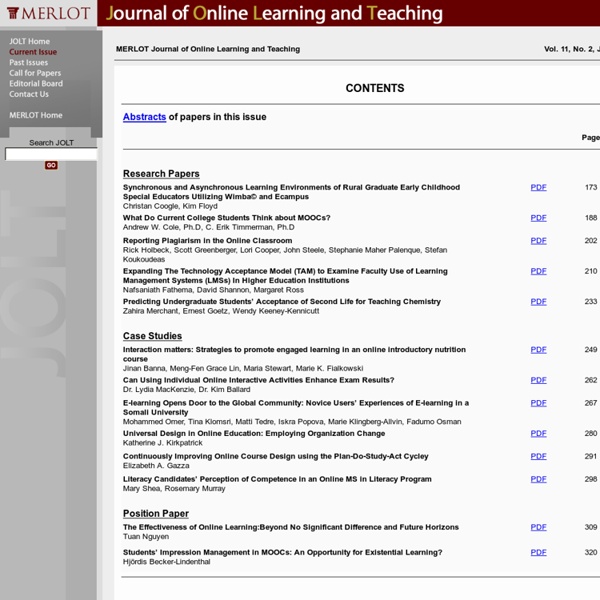



Revue sticef.org Blog | Curatr First Friday Bring Social Learning to Retail with Kaboodle A version of this post first appeared on the HT2 Blog. Earlier this year we launched a new digital learning and social collaboration platform built specifically with retailers in mind with our Partner, First Friday. 6-months post-launch and Kaboodle is starting to... read more How to Handle Your First Curatr Implementation: Advice from A Project Manager This post first appeared on the HT2 Blog. Future Tech: Proximity Beacons in Learning This post first appeared on the HT2 Blog. Popular ‘Introduction to the xAPI’ MOOC Returns to the Curatr Free Course Line-up As part of a lineup of free courses, Curatr’s parent company, HT2, have announced a revised version of the highly successful “Introduction to the xAPI” MOOC, which first ran in Summer 2015, and saw over 800 people from across the globe taking part in a 4-week... read more Curation, Copyright and the Law This post first appeared on the HT2 blog. How to Gamify your MOOCs
MOOC, 8 tipologies | ladislau girona Recentment he llegit un article al blog de Donald Clark parlant dels MOOCS i les seves diferents tipologies des d’una perspectiva pedagògica, des del punt de vista dels instruments d’aprenentatge que incorporen . En primer lloc ens parla dels TransferMOOCs, la oferta de Coursera entraria dins aquesta categoria. Es tracta de traslladar a una plataforma MOOC els cursos existents; estan conduits pel professor, el supòsit pedagògic és el de la transferència de continguts, molts imiten els cursos tradicionals amb l’ús de conferències, proves curtes, avaluacions. És la opció mes moderna dels cursos tradicionals. En segon lloc, els MadeMOOCs, Udacity es qui representa millor aquesta categoria. Més innovadors en l’ús del vídeo, defugint els “talking heads”. En tercer lloc, els SynchMOOCs, cursos amb data d’inici i d’avaluació fixes. En quart lloc, els AsynchMOOCs, cursos totalment oberts, sense dates fixes d’inici o avaluació. En cinquè lloc, els AdaptativeMOOCs.
Alsic - Apprentissage des Langues et Systèmes d'Information et de Communication Blended Learning Essentials: Getting Started - University of Leeds This course is designed to help anyone teaching in the vocational education and training (VET) sector understand the benefits of blended learning. You will find out how to use technology more effectively to support your learners, and understand how to better embed it in your classroom. Supported by industry experts, you’ll connect with teaching and training professionals who understand the practical challenges of using blended learning. You’ll discover the importance of being able to blend digital learning methods into your teaching, to help your learners become familiar with the digital workplaces they’ll be joining. Prepare to embed blended learning in your teaching practice You’ll learn the principles of blended learning and will review a number of case studies to see how it can be applied in different environments. Consider how your VLE can support blending learning Design blended learning options that suit your learners
RESEAU : revue interne de pédagogie universitaire Aller au contenu. | Aller à la navigation Université Facultés Études et Formations Recherche Service à la société International Service de pédagogie universitaire UNamur / Département éducation et technologie / Service de pédagogie universitaire / Revue RESEAU RESEAU : revue interne de pédagogie universitaire RESEAU ou REvue au Service de l'Enseignement et de l'Apprentissage à l'Université. RESEAU 89 : Physique et défis. RESEAU 88 : Former les étudiants vétérinaires par la recherche RESEAU 87 : Vers un enseignement ouvert sur le monde en infocom RESEAU 86 : QCM Help ou comment préparer les étudiants aux examens par Questions à Choix Multiple? RESEAU 85 : Travaux pratiques trans-générationnels et multidisciplinaires en médecine veterinaire RESEAU 84 : La Valorisation des acquis de l'expérience, un nouveau défi pour les jurys universitaires RESEAU 83 : Classe inversée et enseignement par les pairs en médecine RESEAU 82 : Ils ne savent pas rédiger... RESEAU 76 : On ne naît pas étudiant...
Digital Literacies ANZ – Connecting digital learning with digital fluency Revue Pédagogie collégiale Depuis 1987, Pédagogie collégiale parait habituellement quatre fois par année : automne (octobre), hiver (décembre), printemps (mars) et été (mai). La revue présente des articles proposés par des acteurs du milieu de l’éducation, surtout du collégial. Pédagogie collégiale est d’abord une revue phare pour les acteurs de l’enseignement supérieur. Elle cherche notamment à guider les interventions en matière de pédagogie collégiale en présentant une information riche et variée, ainsi qu’à annoncer les changements pressentis dans le milieu de l’éducation. Elle est aussi une revue reflet, enracinée dans la réalité, témoin des pratiques qui constituent le milieu collégial. La revue s’adresse tout particulièrement aux praticiens des collèges québécois (professeurs, professionnels, techniciens et cadres des collèges publics et privés) qui œuvrent tant à l’enseignement régulier qu’à la formation continue, de même qu’aux pédagogues issus des autres réseaux d’enseignement. Description des rubriques